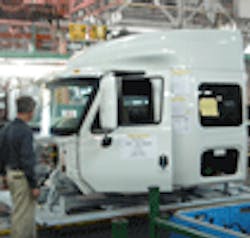Truck OEMs moving toward building new breed of “low-cost” models
At the Heavy Duty Aftermarket Week (HDAW) meeting next week in Las Vegas, research firm Frost & Sullivan will unveil a detailed analysis of what it calls the “low cost truck” movement. The research firm describes this as a strategic initiative by truck manufacturers either individually or through joint ventures that will completely reshape the types of commercial vehicles used around the world.
“What we’re seeing is a determined effort to build trucks that cost 20% to 25% less in any given global market – from North America to Brazil, Russia, and Europe,” Sandeep Kar, global program manager--commercial vehicle research for Frost & Sullivan, told Fleet Owner. “And this effort will cover the entire commercial vehicle spectrum, from light- to medium- and heavy-duty models.”
For the study – titled Strategic Analysis of the Global Low Cost Truck Market – Frost & Sullivan interviewed OEMs and suppliers from around the world, conducted its own research, and then made near-term projections for the low-cost strategy spanning 2010 to 2016.
Kar said the firm’s research indicates new low-cost price ranges will develop as follows: $4,000 to $20,000 for a light commercial vehicle (LCV); $15,000 to $40,000 for a medium commercial vehicle (MCV); and $30,000 to $70,000 for a heavy commercial vehicle (HCV).
According to Kar, the impetus for this strategy on the part of truck builders is that commercial fleets are simply under far too much bottom-line pressure today – paying for higher fuel prices, the cost of regulatory compliance, higher pay to compete for workers – to afford ever-higher sticker prices on new equipment.
Dahlman Rose transportation economist Jason Siedl noted at FTR Associates’ annual freight outlook conference last September that the average cost for a new Class 8 tractor is up to $120,000 in the U.S. One fleet at that meeting said that its Class 8 tractor costs increased $25,000 per unit from 2002 to 2010.
It’s the financial pressure those high prices put on U.S. fleet owners that in turn is driving the effort to create low cost trucks, said Frost & Sullivan’s Kar.
“We expect to see phenomenal growth in the North American market for low cost trucks,” Kar pointed out. “Our research indicates the average base price point for a heavy-duty truck in North America is about $104,000. Now say some $10,000 to $15,000 worth of emission control and safety systems need to be added to the low-cost truck platform to bring it into regulatory compliance. You’d still be looking at a truck that is $80,000 to $95,000-- still cheaper than current prices today.”
Continue reading "Truck OEMs moving toward building new breed of “low-cost” models".Of course, such low- cost trucks would not contain the same amenities found on many of today’s commercial vehicles – especially in terms of driver-comfort specs. For that reason, Frost & Sullivan contends the North American truck market will become two-tiered, having a low-cost and a premium segment, with mid-priced models disappearing.
“We would also not see the low-cost model challenge the long-haul Class 8 sleeper segment,” he noted. “Rather, we’d see the low-cost Class 8 model dominate the short-haul daycab segment.”
The key to making these low-cost trucks a reality, however, will rest on creating a far larger global manufacturing scale than exists now-- along with a global supplier network. “Making a low-cost truck means cutting costs throughout the vehicle,” Kar observed.
Per Frost & Sullivan, areas where costs will be cut include:
- 5% to 8% from powertrains
- 3% to 4% from chassis
- 3% to 4% from driver comfort and amenities
- 3% to 4% from engines
- 1% to 2% from marketing efforts
Overall, total production costs for a low- cost truck platform should fall anywhere from 19% to 29%, Kar said.
Yet can the low-cost trucks find willing fleet buyers in the U.S.? Kar definitely thinks so. “Total cost of ownership or ‘TCO’ is now the most critical metric within most fleets,” he explained.
“Access to financing is still limited and after the recent economic downturn, fleets still have little cash to spend,” Kar added. “In a way, fleets will almost be forced to look at low-cost truck models due to the operating conditions they will continue to face.”
About the Author
Sean Kilcarr
Editor in Chief
Sean Kilcarr is a former longtime FleetOwner senior editor who wrote for the publication from 2000 to 2018. He served as editor-in-chief from 2017 to 2018.
